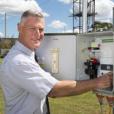
Showing 581 - 600 of 774 results

Elizabeth joined ANSTO at the beginning of 2024 and works as a Research Support Officer for Environment where she is involved in diverse research including ground water sampling and coral provenance.

Tara Djokic is a geologist currently based in the Palaeontology Department of the Australian Museum Research Institute where she is investigating the fossilisation processes of an 11-16 million-year-old rainforest-lake deposit from central N

Role at ANSTO
Services
ANSTO waste management services meet regulatory requirements and international best practice standards.
International collaboration identifies potential threat to water quality
A major study has identified urbanisation and climate change as future threats to drinking water quality.

Dr. Sue Brown is a Senior Radiochemist within the ANSTO Minerals business unit.
New imaging approach using live plants will benefit agriculture and environment
A cross-disciplinary team has used laboratory-based and synchrotron-based infrared spectroscopy imaging techniques to monitor the waxy surface of living plant leaves in real-time to gain insights into plant physiology in response to disease, biological changes or environmental stress.
ANSTO joins Australian Government delegation at IAEA’s ICONS 2024 conference on nuclear security
Nuclear security experts and officials from Australia’s nuclear agencies have convened at the International Atomic Energy Agency’s (IAEA) headquarters in Vienna, Austria last week for the International Conference on Nuclear Security (ICONS).
ANSTO welcomes federal funding announcement to support research infrastructure and expertise

Role at ANSTO
Establishing global connections on quality seafood production and authenticty
ANSTO shares expertise on food authenticity research using nuclear techniques with Southeast Asia stakeholders.
New technologies will deliver new answers to old questions about depression: Lecture by Prof Ian Hickie
Funding and infrastructure boost for Australian Synchrotron
$80.2 million in new funding to expand the research capabilities of the Australian Synchrotron.
Outstanding individuals recognised in ANSTO Awards
Outstanding individuals and teams have been recognised for their outstanding work, innovation, excellence in the 2025 ANSTO Awards.
Understanding corrosion in concrete sewer pipes
Using neutron imaging techniques at ANSTO, researchers from Macquarie University have gained a better understanding of how corrosion forms and spreads through concrete that is commonly used in sewer pipes.
Researcher-adventurer to share expedition video and photos
ARC Discovery project funding for geometry of the genome and the engineering of solid-state sodium batteries announced
Three ANSTO scientists are contributing to two recently awarded Australian Research Council Discovery Project grants.
Progress on dark matter lab
Moving earth in the search for dark matter: laboratory construction underway at mine site.
Taiwan science organisations and ANSTO celebrating ten years of operation of an advanced instrument
A delegation of Taiwanese officials and ANSTO staff celebrated the 10th anniversary of the operation of an advanced scientific instrument, a cold neutron triple axis spectrometer Sika on 4 September.